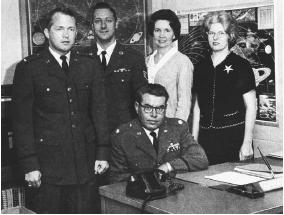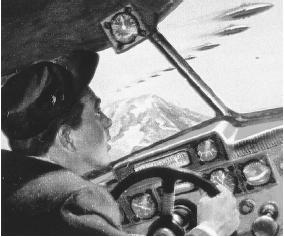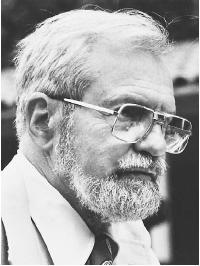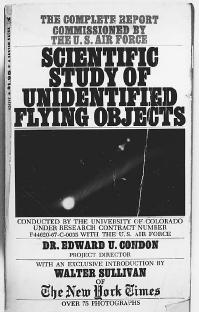The Modern UFO Era Begins
The air force and project blue book
On June 24, 1947, when civilian pilot Kenneth Arnold sighted nine discs near Mount Rainier in the state of Washington and described the motion of the unidentified flying objects as looking like "a saucer skipping across the water," the Boise, Idaho, businessman inadvertently coined a term that would become known in most languages of the world,

During the period June through December 1947 there was no specific organization responsible for investigating and evaluating UFO reports. At this time everyone had an expert opinion. Even within the military structure, there were those who expressed their own feelings and beliefs as to what UFOs actually represented.
The wide news coverage of public reports of "flying discs or saucers" created sufficient concern at high military echelons to authorize the Air Material Command (AMC) to conduct a preliminary investigation into these

A letter (September 23, 1947) from Lt. General Twining of AMC to the commanding general of the Army Air Forces expressed the opinion that there was sufficient substance in the reports to warrant a detailed study. On December 30, 1947, a letter from the chief of staff directed AMC to establish a project whose purpose was to collect, collate, evaluate, and disseminate all information concerning UFO sightings and phenomena in the atmosphere to those interested agencies. The project was assigned the code name "Sign." The responsibility for "Project Sign" was delegated to the Air Technical Intelligence Center, which was then part of the AMC. In February of 1949 "Project Sign" completed its evaluations of the 243 UFO reports that had been submitted to the project. The report concluded that: "No definite and conclusive evidence is yet available that would prove or disprove the existence of these UFOs as real aircraft of unknown and unconventional configuration."
"Project Sign" was changed to "Project Grudge" on December 16, 1948, at the request of the director of Research and Development. Project Grudge completed its evaluations of 244 reports in August 1949. The conclusions of the Grudge reports were that the evaluations of reports of UFOs to date had demonstrated that "these flying objects constitute no threat to the security of the United States." Grudge also concluded that reports of UFOs were the result of misinterpretations of conventional objects, a mild form of mass hysteria or war nerves, and individuals who sought to perpetrate a hoax or seek publicity. Project Grudge also recommended that the investigation and study of reports of UFOs be reduced in scope.
Air force investigation of UFOs continued on a reduced scale, and in December 1951 the Air Force entered into a contract with a private industrial organization for another detailed study of the UFO cases on file. The report, which was completed March 17, 1954, is commonly referred to as Special Report Number 14. Reports one through 13 were progress reports dealing with administration. Special Report Number 14 reduced and evaluated all UFO data held in air force files. Basically, the same conclusions were reached that had been noted in both the preceding Sign and Grudge reports.
It was during the early 1950s that the national interest in reported sightings increased tremendously. With the growing volume of reports, a Scientific Advisory Panel on UFOs was established in late 1952. At a meeting held during January 14–18, 1953, all available data was examined. Conclusions and recommendations of this panel were published in a report and made public. The panel concluded that UFOs did not threaten the national security of the United States and recommended that the aura of mystery attached to the project be removed.
In March of 1952 Project Grudge became known as Project Blue Book. From this time to its conclusion in 1969, the project concerned itself with investigation of sightings, evaluation of the data, and release of information to proper news media through the Secretary of the Air Force, Office of Information (SAFOI). The staff of Project Blue Book was assigned to carry out three main functions: to try to find an explanation for all reported sightings of UFOs; to determine whether the UFOs posed any security threat to the United States; and to determine if UFOs exhibited any advanced technology that the United States could utilize.
Blue Book officers were stationed at every air force base in the nation. They were responsible for investigating all reported sightings and for getting the reports into Blue Book headquarters at Wright-Patterson Air Force Base. The bulk of the investigations, as interpreted by field officers, led Blue Book officials to decide that most people did not see extraterrestrial spacecraft, but bright stars, balloons, satellites, comets, fireballs, conventional aircraft, moving clouds, vapor trails, missiles, reflections, mirages, searchlights, birds, kites, spurious radar indications, fireworks, or flares.
Dr. J. Allen Hynek, who for more than two decades served as an astronomical consultant to Project Sign and Project Blue Book, had been teaching astronomy at Ohio State University in Columbus, which is not far from Dayton, where Wright-Patterson Air Force Base, the home of Project Blue Book, was located. When he entered the project, the government was trying desperately to determine whether it was the Martians or the Russians who were responsible for the elusive discs being tracked in the atmosphere over North America. The air force appealed to Hynek that they needed a competent astronomer to tell them which cases arose out of the misidentification of planets, stars, meteors, and so forth. Hynek admitted later that he was certain that the UFO phenomenon was a result of postwar nerves, and he was certain that in a few years the whole strange business would be forgotten. He also prematurely concluded that the flying saucers were strictly an American fad. He never suspected that it would turn out to be a global phenomenon. But the famous sightings in Michigan in March and April 1967, the ones that got Dr. Hynek dubbed "Dr. Swamp Gas," demonstrated to "Blue Book's tame professor" that there was a "backlash of public sentiment." For the first

Hynek said that two factions definitely existed in Project Blue Book. There were those individuals who were extremely concerned over the radar trackings and the close approaches made by UFOs to civilian and military aircraft. These investigators assumed that the pilots were being truthful and were not concocting weird tales. These open-minded Blue Book personnel wanted to check all the possibilities. But most of the top brass, Hynek commented, couldn't understand for a split second why any of their colleagues would bother to take seriously the subject of UFOs. In what would become an often-quoted observation, Hynek said, "Scientists in the year 2066 may think us very naive in our denials."
Project Blue Book, begun as Project Sign in 1947, produced what the air force considered a satisfactory explanation for most of the

On the basis of Blue Book reports, therefore, the air force concluded:
- No UFO has ever given any indication of threat to the national security.
- There is no evidence that UFOs represent technological developments or principles beyond present-day scientific knowledge.
- There is no evidence that any UFOs are "extraterrestrial vehicles."
The transfer of the responsibility of UFO research to the University of Colorado in 1969 served to terminate the air force's official involvement in the UFO mystery, but the residue of suspicions and outright accusations of government cover-up and censorship has never been dissipated.

Comment about this article, ask questions, or add new information about this topic: